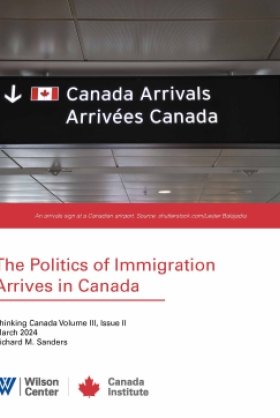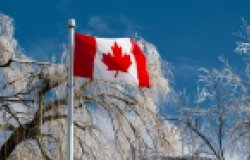Education and Immigrant Integration in the U.S. and Canada
This conference provided scholars and policy-makers from Canada and the United States the opportunity to assess problems and compare best practices regarding education and immigrant integration.
Overview
The Honorable Marie Bountrogianni, Ontario Minister of Citizenship and Immigration; Joseph Chamie, United Nations Population Division; Alec Ian Gershberg, World Bank; Margaret McHugh, New York Immigration Coalition; Fariborz Birjandian, Calgary Catholic Immigration Society; Charles Ungerleider, University of British Columbia; Heide Spruck Wrigley, Literacy Work International; B. Lindsay Lowell, Institute for the Study of International Migration, Georgetown University; Sabra Desai, Humber Institute of Technology and Advanced Learning; Howard Duncan, Metropolis Project
Education and immigrant integration are vital concerns of the nation-state, as demographer Joseph Chamie said in the opening address of a conference convened by the Division of U.S. Studies, the Canada Institute, and the Migration Policy Institute on April 25, 2005. Recognizing that the two countries approach what Chamie called these extremely complex and controversial matters in somewhat different ways, the conference was organized so that scholars and policy-makers from Canada and the United States could assess problems and compare best practices.
Chamie noted that almost all current significant population growth takes place in developing nations, and that this has obvious implications for migration. Without immigration, Canada's population would decline slightly by 2050, the United States would experience only modest growth, and the population of both countries would be considerably more elderly. The two nations have each begun to experience competition between the aged and the young for limited resources. In order to address the consequences of immigration, receiving states must ask questions such as: What does immigrant integration mean? What types of education and training should be made available to newcomers, whose languages, cultural backgrounds, and skills differ to varying degrees from those of native Canadians and Americans? What timeframe is relevant for resolving issues pertaining to immigration flows? Which immigrant groups are most affected when countries devise education policies that take gender, age, and language into consideration?
Speaking on the panel on primary and secondary (K-12) education, Alec Ian Gershberg commented that newcomer policy is being made in U.S. classrooms every day, in part because of the absence of coherent national immigrant policy. One unanswered question is the difference between immigrant learners and English language learners, as the latter category can also describe native-born Americans. More than 10% of the students in public schools are immigrant English language learners and are concentrated in the poorer schools, which have teachers with less education and experience. Current policy, including that embedded in the No Child Left Behind Act (NCLB), treats all students in the same way, no matter what or how they did in schools in their home countries. This ignores the question of how to measure student need. Gershberg also took issue with NCLB's modification of the eligibility criteria for bilingual education funding. It shifts funding from school districts with large numbers of immigrants to those with a large growth in immigrants, resulting in cutbacks for districts such as San Francisco but increases for districts in smaller districts in Nebraska. Margaret McHugh added that in New York City, the debate is no longer about bilingual education because schools rarely contain the 15 students in a grade required to create a bilingual education program: immigrant children come from such a diversity of linguistic backgrounds that language isolation is a new concern. She suggested that teachers be given time and funding to earn an English Language Literacy (ELL) credential, and that consideration be given to permitting immigrant students to take a year off to concentrate on intensive language acquisition. Because immigrants in New York are now the largest group of new voters, the politics of school funding may change during coming years.
Exploring the Canadian experience, Fariborz Birjandian told the audience that provincial governments have to accommodate 40,000 newcomers in public schools annually. They come from more than 100 countries, 80% of which are non-English-speaking. Almost 90% of them will go to school in Montreal, Toronto, or Vancouver, and Birjandian suggested considering national policies that would distribute immigrants more evenly around the country. Because it takes an average of five to six years for newly arrived immigrants to acquire voting rights, current policies do not reflect their concerns. Immigrants are simultaneously faced with the difficulty of living between two worlds, economic hardship, and the complexities of the second language learning process. While Canada's integration policies are better than most, the current system, Birjandian charged, fails young people ages 16-19, 70% of whom do not graduate from high school. Charles Ungerleider approached the problem differently, arguing that only 30% of school failures can be attributed to education programs or school curricula rather than to factors outside the school walls, and that education would be more successful if were attached to other social policies such as adequate wages, health coverage, and parenting leave. He contrasted Canadian immigration policy since 1967 with that of the United States, as Canada now emphasizes immigration based on merit and the possession of skills that will both contribute to Canadian society and alleviate the integration process.
Heide Spruck Wrigley began the panel on adult literacy and workforce training by noting that for many adult immigrants, federally funded programs such as English for Speakers of Other Languages and Adult Basic Education constitute the first chance to receive an education, while for others the programs may alleviate the difficulties of social isolation, improve employment-related skills, or help get foreign credentials recognized. Teachers face the challenges of insufficient class time in which to teach English as a second language, particularly to adults who frequently lack high school diplomas. A greater focus on learning how to learn, as well as how to learn on one's own, would be useful. Unfortunately, the National Reporting System leads teachers to be more concerned about testing students than with teaching them. B. Lindsay Lowell added that there is a tension between centralized funding for adult education and local control. One half of all the English as a second language training in the United States is for adults, and yet it is inadequate to serve all the people who seek it. The workforce consequences are significant, with English-deficient workers earning about 20% less than their English-fluent counterparts. Lowell saw discrimination against immigrants as occurring not as much at wage levels than during the earlier hiring process. Pre-job workforce training programs may not be effective for many low- skilled immigrants, who tend to learn more through on-the-job training. A key question becomes how to get big business to educate and train immigrants, because at the moment, most such training is supplied only by small and medium-sized businesses.
Canada views immigration as an important part of nation-building, Howard Duncan stated, and integration is an important part of that process. While Canadian immigration policy focuses on attracting skilled workers with substantial language skills and education, Canada is now experiencing underemployment and lengthening catch-up rates for immigrants. Qualifications on paper do not necessarily indicate the ability to speak English well, and research suggests that those who speak English with thick accents face problems ranging from employment discrimination to social isolation. Both the national and provincial governments provide funds to nongovernmental organizations that are frequently ethnically-based, and in the process they increase social capital. This promising development, however, is threatened by recent budget cuts. Even highly skilled newcomers face challenges, according to Sabra Desai, who addressed the continuing problem of how best to utilize the skills of people with advanced degrees and training. Their work experience abroad is frequently not recognized and they may lack timely access to needed information. Desai described opportunity and access as more of a problem for Canada than adult literacy.
The luncheon address was presented by the Honorable Dr. Marie Bountrogianni, who spoke of Ontario's efforts to provide basic education, health care, and social services to its immigrant communities. Ontario is the home of 57% of all newcomers to Canada, and 27% of its population is foreign-born. Recognizing that "immigration is our province's greatest advantage," and that the developed world is competing to attract the brightest and the best, Bountrogianni emphasized Ontario's "profound respect for diversity" and its increased funding for ESL programs, its projects for integrating professionals, and its current review of occupational licensing procedures. She cited the need for incentive programs to encourage immigrants to settle in rural areas and suggested the creation of municipal, provincial, and national websites with information for immigrants. In what might be read as a lesson for all nations experiencing immigration, she described Ontario's immigration policy as a pragmatic one, based on the knowledge that the province's economy relies overwhelmingly on trade and services and that, therefore, "people plus skills equals prosperity."
Philippa Strum, Director, Division of U.S. Studies 202-692-4129
David Biette, Director, Canada Institute 202-691-4133
Hosted By

Canada Institute
The mission of the Wilson Center's Canada Institute is to raise the level of knowledge of Canada in the United States, particularly within the Washington, DC policy community. Research projects, initiatives, podcasts, and publications cover contemporary Canada, US-Canadian relations, North American political economy, and Canada's global role as it intersects with US national interests. Read more
Thank you for your interest in this event. Please send any feedback or questions to our Events staff.










